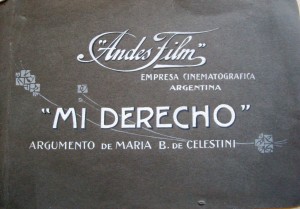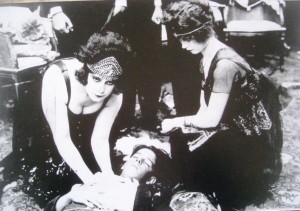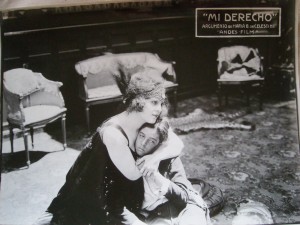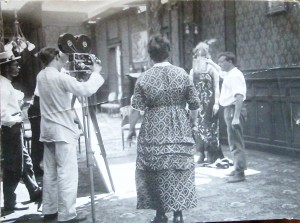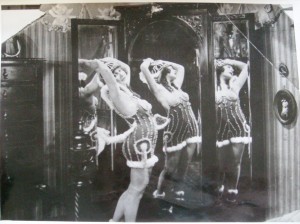Women in Argentine Silent Cinema
By Moira Fradinger
A vibrant and growing Italian community settled in Argentina as far back as the early nineteenth century and rapidly increased at the turn of the century with a massive flow of immigrants. As in other countries of the continent, Italians disembarked in Buenos Aires with the hope to “make it in America.” But unlike in other countries, they were not only manual laborers. They were also professionals, artists, photographers, musicians, theater actors, and, not to be forgotten, political exiles coming from the ranks of communist and anarchist turn-of-the-century Italy. Unlike in New York, Italians disembarking in Buenos Aires mostly came not from the South but from the North; they all found a country not “made” but “to be made.” Some of these immigrants were just touring through Buenos Aires and decided to remain in the teeming city that was barreling “full steam” towards industrial modernity. Although the overwhelming majority of these travelers were Italians and Spaniards, the wave also brought every kind of European.
Few cities in the world were so foreign in the make-up of their population at the time. The municipal census of 1909 shows Buenos Aires had 1,231,698 inhabitants, of which 670,513 were Argentine, 561,185 were foreign (46%). Among the latter, 174,291 were from Spain and 277,041 were Italians (“El Censo de 1909,” 109). It is estimated that from 1869 to 1915, 45% to 53% of the population of Buenos Aires remained of foreign origin, and 80% was composed of foreigners and children of foreigners. By 1914, 80% of immigrants to Argentina were either Italians or Spaniards and Italians composed from 25% to 32% of the foreign population of Buenos Aires (Argentina National Census 1914, 83-94). Business and industry largely depended on this immigrant wave. The film industry was no exception. The “kinescope” entered the country thanks to the German Federico Figner, who also filmed the first views of the city. The photographic equipment firm Lepage pioneered the importation of Gaumont cameras: the owner, Enrique Lepage, was Belgian. Lepage’s collaborator, Eugenio Py, filmed the first short documentary, La bandera argentina/The Argentine Flag (1897) and the first professional news report, El viaje a Buenos Aires del Dr. Campos Salles/Dr. Campos Salles’s Trip to Buenos Aires (1900). Py was French. Another of Lepage’s collaborators, the Austrian Max Glucksmann, was the pioneer of the production and exhibition of films in the Argentine capital. Mario Gallo, an Italian, directed the first Argentine fiction film, La Revolución de Mayo/The May Revolution (1909). Federico Valle, another Italian, filmed the first weekly newsreel (Film Revista Valle, 1916-1931) (Marrone 2003, 27-57; Finkielman 2004, 5-31; Zago 1997, 1-23; Caneto et al. 1996; Couselo 1984, 11-22).
Three women working in the film industry during the silent period have appeared in citations, but little is known of them. María B. de Celestini filmed Mi Derecho in 1920 and is invariably mentioned in film histories, but so far we do not possess any of her biographical information. Her film seem to have been destroyed in a fire, although the Cinemateca Argentina has production stills from Mi Derecho. Paraná Sendrós, in his article for the newspaper Ámbito Financiero (1988), mentions that the film had to be finished by the director of photography Alberto Biasotti, a major associate of the Ariel studios in Buenos Aires (n.p). To judge from the stills, the film was produced by Andes films and the story was written by Celestini, whose child seems to have been one of the actors. From the images, we can reconstruct that the film is a moral drama involving a woman perhaps of “low life” or “dubious reputation,” as well as a child and a man. The woman is dressed for a cabaret performance of some kind; the child is beaten by the man and the woman is shown consoling the child who lies on the floor of what we presume is the cabaret where she works.
René Oro (also Renée) is also mentioned as having directed the documentary film La Argentina (1922), but more research into this film and other possible documentaries is necessary (Finkielman 48). La Patria mentions Elena Sansinena de Elizalde as having written and directed Blanco y negro/ Black and White, which premiered on November 22, 1919, at the Grand Splendid Theater (“Blanco y Negro” 5). The film is usually listed as having been directed by Francisco Defilippis Novoa in 1919, and starring Victoria Ocampo, who by then was a friend of Sansinena and who would later become a famous writer (Zago 28). Daughter of land-owners in the province of Buenos Aires, Sansinena was the founder and president of a vibrant all-female cultural association in Buenos Aires, La Asociación Amigos del Arte (1924-1942), which had a strong impact on the cultural scene of the city.
Bibliography
Argentina National Census 1914. Redalyc vol. 5, no. 8 (October 2008): 83-94.
“Blanco y Negro.” Rev. La Patria (9 November 1919): 5.
Caneto, Guillermo, et al. Historia de los primeros años del cine en la Argentina, 1985-1910. Buenos Aires: Fundación Cinemateca Argentina, 1996.
Couselo, Jorge M., et al. Historia del Cine Argentino, Buenos Aires: Centro Editor de América Latina, 1984.
“El Censo de 1909 de la ciudad de Buenos Aires.” Redalyc vol. 5, no. 7 (April 2008): 109.
Finkielman, Jorge. The Film Industry in Argentina: an Illustrated Cultural History. Jefferson: McFarland, 2004.
Marrone, Irene. Imagenes del Mundo Historico: Identidades y Representacions En El Noticiero y El Documental En El Cine Mudo Argentino. Buenos Aires: Editorial Biblios, 2003.
Sendrós, Paraná. “La Celestini hizo un solo film.” Ámbito Financiero (4 April 1988): n.p.
Zago, Manrique, ed. Cine Argentino: Crónica de 100 años. Buenos Aires: Manrique Zago Ediciones, 1997.

